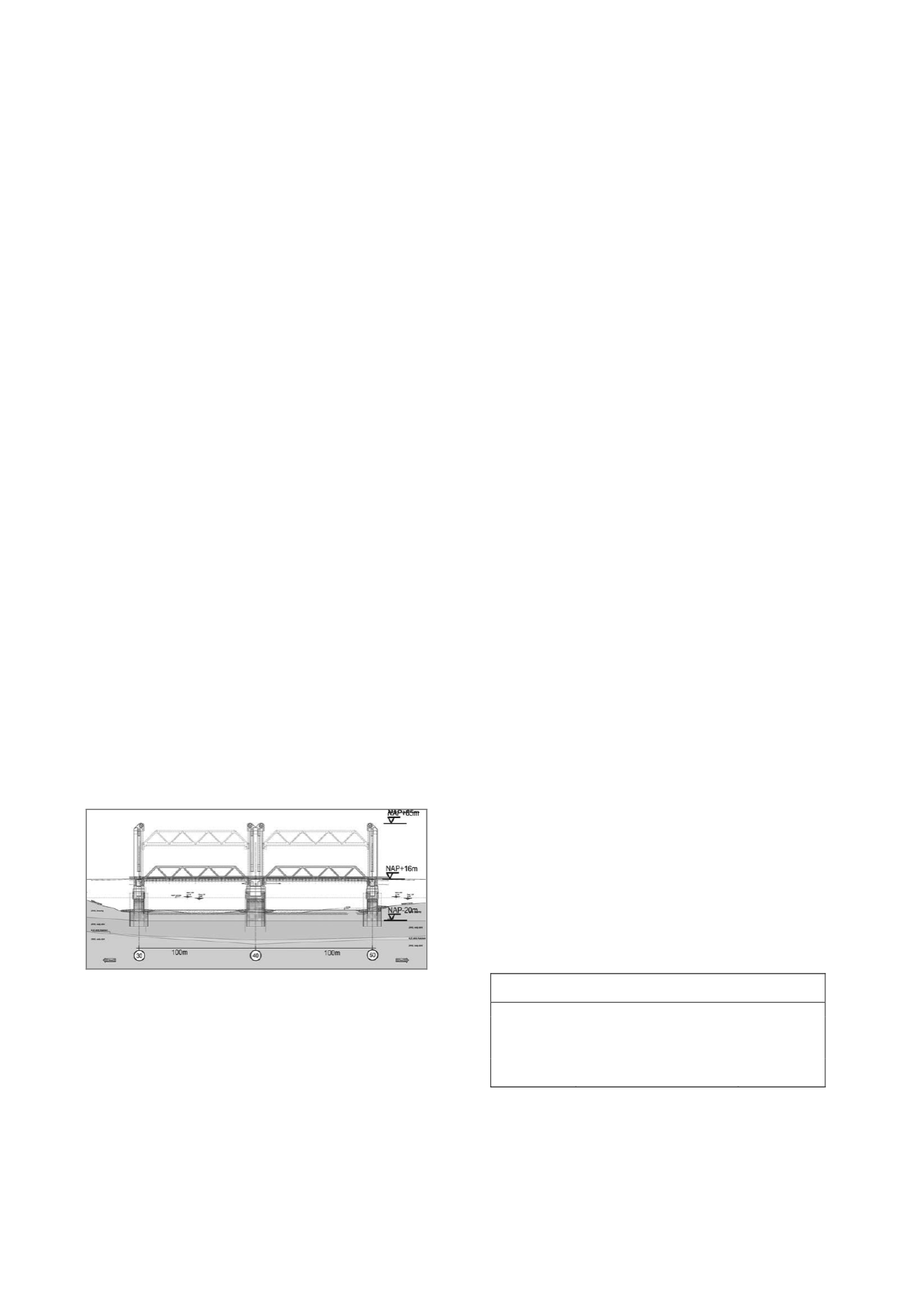
1295
Probabilistic Settlement Analysis For The Botlek Lifting Bridge Design
Analyse probabiliste de tassement pour la conception du pont levant Botlek
Jacobse J.A., Nehal R.S.
GEO2 Engineering B.V.
Rijneveld B.
Fugro GeoServices B.V.
Bouwmeester D.
Ballast Nedam Engineering B.V.
ABSTRACT: A new lifting bridge is being constructed crossing the river Oude Maas in the Rotterdam harbour area in the
Netherlands. For the deformation analysis deterministic 3D FEM calculations were performed. In order to take the effect of soil
heterogeneity on the deformation behaviour of the bridge piers into account, a probabilistic model has been developed. This model
and the applications are described in this paper. The application of a simplified stochastic subsoil model enables a quantitative risk
analysis in order to deal with this uncertainty. Furthermore the model is used to determine design values of the deformations of
several components of the bridge.
RÉSUMÉ : Au port de Rotterdam aux Pays-Bas on construit un nouveau pont levant qui traverse la rivière Oude Maas. Des calculs
déterministes 3D FEM sont effectués pour analyser la déformation. On a développé un modèle probabiliste pour tirer l'effet de
l'hétérogénéité du sol sur la déformation des piles du pont. Cet article décrit ce modèle et ses applications. L'application d'un sous-sol
simplifié et stochastique permet une analyse de risque quantitative qui sait régler l'incertitude des paramètres du sous-sol. En outre le
modèle est utilisé pour déterminer la valeur de calcul des déformations des différentes pièces du pont.
KEYWORDS: Foundation design, shallow foundation, soil heterogeneity, probabilistic deformation analysis, quantitative risk
analysis
MOTS-CLES: Calcul de fondations, foundation superficielle, hétérogénéité, analyse probabiliste, analyse quantitative, analyse de
risques
1
INTRODUCTION
The Dutch highway A15 in the Rotterdam harbour area is
being widened due to an increase in traffic load. One of the
main challenges in this project is the construction of a new
lifting bridge over the river Oude Maas. Consisting of two
lifting spans of approximately 100 m and pylons reaching over
60 m above water level, this new bridge will be one of the
largest lifting bridges in Europe (see Figure 1).
Figure 1. Typical cross section of new Botlek Lifting Bridge
The three main bridge piers (from left to right in Figure 1:
Pier 30, Pier 40 and Pier 50) are founded on rigid concrete
blocks with footing dimensions of 15 x 60 m, at 8 m below river
bed at the top of the first dense (Pleistocene) sand layer. For the
geotechnical design the foundation was essentially treated as a
shallow foundation.
At a depth of approximately 16 m below the foundation
footing a relatively soft clay layer is present with varying
thicknesses between 0 and 4 m. This stratum complicated the
design, especially with respect to the settlement behaviour
which has a major impact on the performance of the total bridge
and influences the different design disciplines (e.g. mechanical,
electrical and structural). This article considers the risk analysis
with respect to the deformation behaviour of the subsoil which
was undertaken as part of the foundation design.
2
SOIL INVESTIGATION AND PARAMETER
DETERMINATION
For the determination of the soil parameters an extensive soil
investigation has been performed. A relatively dense grid of
Cone Penetration Tests (CPT’s) with a mutual distance of about
15 m was executed to a depth of about 3 times the foundation
width. In addition, a number of boreholes were drilled and
undisturbed samples were taken at regular intervals for
geotechnical laboratory tests by means of light percussion
drilling in combination with thin-walled samplers. From the
CPT’s and borehole logs the soil stratigraphy is determined, see
Table 1.
Table 1. General soil stratigraphy
Top of layer
[m NAP]
Soil description
Soil layer
-7 à -14
SAND, clayey
cover layer
-14 à -20
SAND, (medium) dense
1
st
sand layer
-33 à -39
CLAY, stiff
deep clay
layer
-34 à -42
SAND, (medium) dense
2
nd
sand layer
-60
Max. investigation depth
The thickness of the deep clay layer varies strongly. At some
locations the thickness is about 4 m, whereas this layer was not
encountered at other locations.
Classification tests, such as particle size distribution
(granular layers) and volumetric weight and water content


